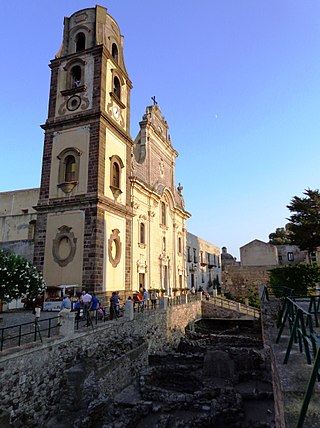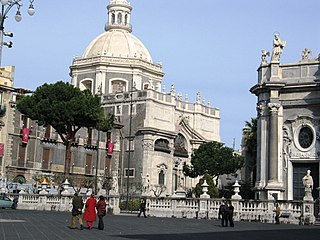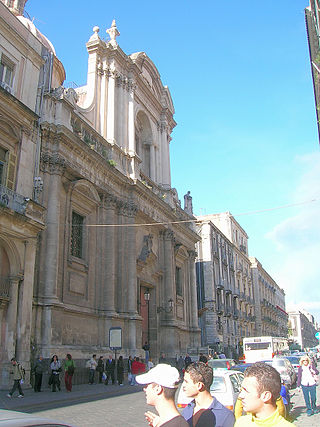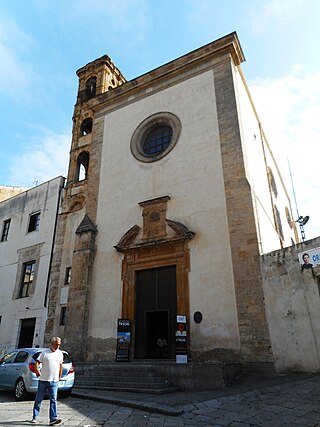
Syracuse is a historic city on the Italian island of Sicily, the capital of the Italian province of Syracuse. The city is notable for its rich Greek and Roman history, culture, amphitheatres, architecture, and as the birthplace and home of the pre-eminent mathematician and engineer Archimedes. This 2,700-year-old city played a key role in ancient times, when it was one of the major powers of the Mediterranean world. Syracuse is located in the southeast corner of the island of Sicily, next to the Gulf of Syracuse beside the Ionian Sea. It is situated in a drastic rise of land with 2,000 metres (6,600 ft) depths being close to the city offshore although the city itself is generally not so hilly in comparison.

Lucia of Syracuse (283–304AD), also called Saint Lucia was a Roman Christian martyr who died during the Diocletianic Persecution. She is venerated as a saint in Catholic, Anglican, and Eastern Orthodox Christianity. She is one of eight women explicitly commemorated by Catholics in the Canon of the Mass. Her traditional feast day, known in Europe as Saint Lucy's Day, is observed by Western Christians on 13 December. Lucia of Syracuse was honored in the Middle Ages and remained a well-known saint in early modern England. She is one of the best known virgin martyrs, along with Agatha of Sicily, Agnes of Rome, Cecilia of Rome, and Catherine of Alexandria.

Padua Cathedral, or Basilica Cathedral of Saint Mary of the Assumption, is a Catholic church and minor basilica located on the east end of Piazza Duomo, adjacent to the bishop's palace in Padua, Veneto, Italy.

San Giuseppe dei Ruffi or church of San Giuseppe dei Ruffo is a church located on piazzetta San Giuseppe dei Ruffi, in Naples, Italy.

Lipari Cathedral is a Roman Catholic cathedral in Lipari in the Province of Messina, Sicily, dedicated to Saint Bartholomew. Formerly the episcopal seat of the diocese of Lipari, it has been since 1986 a co-cathedral in the Archdiocese of Messina-Lipari-Santa Lucia del Mela.

The Cathedral of Syracuse, formally the Cattedrale metropolitana della Natività di Maria Santissima, is an ancient Catholic church in Syracuse, Sicily, the seat of the Catholic Archdiocese of Siracusa. Its structure is originally a Greek doric temple, and for this reason it is included in a UNESCO World Heritage Site designated in 2005.

The Church of Saint Mary of Pity is a Baroque church of Palermo. It is located at the corner of Via Alloro and Via Torremuzza in the quarter of the Kalsa, within the historic centre of Palermo.

Santa Caterina d'Alessandria or Saint Catherine of Alexandria is a Roman Catholic church with a main facade on Piazza Bellini, and a lateral Western facade facing the elaborate Fontana Pretoria, in the historic quarter of Kalsa in the city of Palermo, region of Sicily, Italy. In front of the main facade, across the piazza Bellini, rise the older churches of San Cataldo and Santa Maria dell'Ammiraglio, while across Piazza Pretoria is the Theatine church of San Giuseppe and the entrance to the Quattro Canti. Refurbished over the centuries, the church retains elements and decorations from the Renaissance, Baroque, and late-Baroque (Rococo) eras. This church is distinct from the Oratorio di Santa Caterina found in the Olivella neighborhood.

The Church of Saint Teresa is a Baroque Roman Catholic church, located on Piazza della Kalsa, facing the Porta de Greci in the ancient quarter of the Kalsa of the city of Palermo, region of Sicily, Italy.

Santissimo Salvatore is a Baroque-style, Roman Catholic church and Benedictine monastery located on Via Vincento Gioberti in the town of Noto, region of Sicily, Italy. While the church is still consecrated, the adjacent convent no longer has cloistered nuns and instead houses the seminarians.

San Placido is a Roman Catholic church and former-Benedictine monastery located on the piazza of the same name in Catania, Sicily, southern Italy. The complex, two blocks east of the Catania Cathedral, spans a polygonal block encompassed by the Via Vittorio Emanuele II on the north, the via Landolina to the east, the via Museo Biscari on a south diagonal, and to the west the piazza San Placido and Via Porticello. Part of the convent is occupied by the Palazzo della Cultura, used for cultural activities and exhibitions. The Monastero di San Placido also serves presently as the Archivio di Stato di Catania.

Badia di Sant'Agata or Abbey of St Agatha refers to an 18th-century Roman Catholic church and attached female convent located on Via Vittorio Emanuele #182 in the center of Catania, region of Sicily, Southern Italy. The Baroque style church facade is across the street from the left transept of the Cathedral of Catania.

San Michele Arcangelo ai Minoriti is a Roman Catholic parish church and attached monastery in the city center of Catania, region of Sicily, Italy. The former monastery, to the left of the facade, now houses shops on the ground-floor, and above are the offices of the Provincial government and the Prefettura or Prefecture.
San Camillo dei Mercedari, also called San Camillo de Lellis after its titular saint, or San Camillo ai Crociferi after the founding monastic order founded by Camillo de Lellis, the Camillians known popular as the Crociferi, which also gives name to the street which it faces, via Crociferi. Located on #71, is a Roman Catholic church located in the piazza of the same name in Catania, Sicily, southern Italy; the church is one of four major baroque church-monasteries on this street, the others being San Francesco Borgia (Jesuit), San Giuliano, and San Benedetto.

The Chiesa of Santissima Trinità e San Marziano is a Roman Catholic church located on via San Francesco d'Assisi, 3, just south of the town centre of Lentini, province of Syracuse, Sicily, Italy.

San Giuseppe is a baroque-style, Roman Catholic church located in the piazza of the same name, across the street from the church of San Domenico, on the island of Ortigia, in the historic city center of Siracusa in Sicily, Italy.

San Filippo Neri is a baroque-style, Roman Catholic church located on via Vittorio Veneto, facing seaside, on the island of Ortigia, in the historic city center of Siracusa in Sicily, Italy.

Santa Chiara all'Albergaria refers to a church and former monastery located in piazza Santa Chiara, in the quarter of Albergaria in the city of Palermo, region of Sicily, Italy. The church is located near the busy outdoor Ballarò marketplace.

San Nicola da Tolentino, or more in non-dialect known as the church Saint Niccolò da Tolentino, is a Roman Catholic church located on via Maqueda #157, between via dei Calderai and via Giardinaccio, at the Southwest border of the quarter of Kalsa (Tribunali) of the historic centre of Palermo, region of Sicily, Italy.

San Giovanni dell'Origlione is a Baroque-style,deconsecrated, Roman Catholic church located on Piazza Origlione, at the intersection of via Saladino and via Santissimo Salvatore in the ancient quarter of Albergaria of the city of Palermo, region of Sicily, Italy. It was once attached to a convent of cloistered Benedictine nuns, but after years of abandon, is presently undergoing restoration.



















